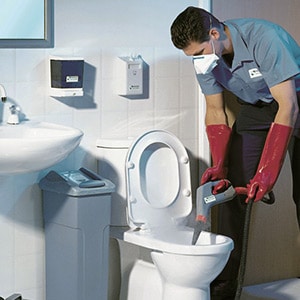Did you know the fear of using public restrooms is known as Paruresis? Also known as bashful bladder syndrome (BBS), shy bladder or urophobia, Paruresis is a logical fear that can affect individuals of all ages and genders.
A research study by BioMed Central indicated that
“Proper hand hygiene may not always be achievable when using public washrooms… Public restroom environments are frequently contaminated and show potential transmission of bacteria or viruses, including antibiotic-resistant bacteria”.
This phobia is therefore commonly brought about by the fact that some public restrooms can be unhygienic, bacteria-infested dens.
So here are some surprising facts about a piece of public restroom equipment that is often overlooked – the urinal.
1. A Urinal Altered the Course of Art History in the 20th Century
This may sound astonishing, but would you believe something as basic as a urinal would be deemed art? French artist Marcel Duchamp revolutionised the art world in April of 1917 when he submitted an art piece to the Society of Independent Artists’ salon in New York.
The Society of Independent Artists’ salon was accepting any work of art as long as the application fee was paid by the artist. The artwork Duchamp submitted was a standard urinal turned upside down and signed “R. Mutt, 1917”, with the title ‘Fountain’.
‘Fountain’ was made to shift the focus from typical works of art to interpretive symbolic art. Because of this work and a few others, Duchamp became known for a style of art known as DADA-ism. This became a movement which many artists channelled their inspiration from.
According to expert art historian Simon Wilson, Fountain
“Reflects the dynamic nature of art today and the idea that the creative process that goes into a work of art is the most important thing, the work itself can be made of anything and can take any form”.
A 2004 poll of 500 art experts from a variety of fields found Duchamps Fountain to be the most influential work of art of the 20th Century.
2. Urinals were Made Popular by the American Industrial Revolution
According to the British Association of Urological Surgeons, the demand for proper hygiene systems dates back as far as the Roman era.
According to legend, a Roman officer was on his way back home from duty and needed to relieve himself. He ended up doing so in a duct that supplied clean water to the town he was passing through. As a result, the legend says that he was arrested, found guilty, castrated and a sanitation system was crafted while the officer lived out his days as a eunuch.
During the 19th Century expansion of American cities, fears concerning the outbreak of diseases due to overcrowding led to the construction of a bigger and more sophisticated sewer system which could accommodate the burgeoning population.
In factories, multiple urinals could occupy the same amount of space as a single sit-down toilet cubicle. This reduced the space needed for men’s washrooms.
Theories in the 1800s concerning worker productivity, such as Taylorism, pointed out the demand for
“Determining the best way for the worker to do the job, to provide the proper tools and training, and to provide incentives for good performance while maximising efficiency”.
As a result, factories were redesigned to include restrooms indoors and closer to the workspace. Installing urinals meant that less time was spent using them compared to single-stall sit-down toilets which were previously located outside.
Women Also Played a Role in the Popularisation of the Urinal
The first upright flushing urinal was patented by Andrew Rankin on March 27th, 1866 in the United States. Although it is rumoured that
“a woman was behind the invention of the upright flushing urinal during the civil war” by the Waterless Co Inc. CEO Klaus Reichardt.
After the end of World War 2 women began streaming into the workforce in greater numbers. The urinal reignited issues of gender equality as men’s washrooms became spots for water cooler privileges to which women were denied.
As women petitioned for equal rights, they unknowingly popularised the use of urinals as men became convinced that urinating while standing up made them superior, which boosted their egos.
The Female Urinal
In a bid to further the fight against gender inequality and decrease the long queues observed in women’s washrooms, female urinals were explored around the same period. However, their awkward designs, potential obstruction of certain female clothing items and little to no marketing caused their popularity to decline.
In recent years, newer models have sprung up but are only in use in specific locations worldwide despite their growth in popularity.
3. The Modern Water-Free Urinal Is One of the Latest Washroom Innovations
The Waterless company first introduced the modern waterless urinal in 1992. Initially, this innovative bathroom equipment faced heavy scepticism. There was strong resistance from the general public, the piping industry and even building owners when it was first launched because of the idea that traditional urinals were more hygienic.
However, it has become increasingly popular over the years as the green building movement has taken place.
Waterless urinals use a removable plastic cartridge filled with a biodegradable liquid sealant that traps gasses and odours as the urine passes through it.
The concept was based on the principles of ecological sanitation to help in preventing environmental challenges that are caused by conventional flush sanitation systems.
Fresh water is becoming increasingly scarce across the globe with residents in major cities dealing with water shortages daily.
Millions of litres of water a day get flushed down the drain in the lavatories of commercial and public facilities like airports, malls and restaurants. One waterless urinal uses about 100 litres of water yearly, compared to their conventional counterparts which can use 75,000-170,000 litres of water per year.
Benefits of installing a waterless urinal include:
- Low maintenance cost
- Reduces infrastructure required for water supply and wastewater treatment
- Cleaner and more hygienic compared to flush urinals
- Conservation of water
- A unique odour trap mechanism which allows it to function without requiring water
Alsco Has You Covered
Commercial facilities face numerous operational challenges with their bathrooms leading to:
- Immense water wastage
- Stains
- Foul odour
- Clogging of drains
- Bad customer experience
Providing a clean and healthy work environment is essential in ensuring the well-being of your employees, clients and visitors. Hygienic conditions keep the working atmosphere healthy and motivating. A dirty work environment can negatively damage the reputation of your business.

Alsco NZ provides an array of cleaning services at reasonable costs and guarantees consistent, high-quality cleaning services that keep all your surfaces and bathrooms clean while you stay focused on your business needs and concerns.
Their deep cleaning service uses state of the art cleaning equipment ensuring that every surface is thoroughly cleaned and disinfected therefore minimising the spread of germs and bacteria.
This ensures that every part of your organisation becomes vibrant and service-oriented.
Alsco NZ will make upgrading your cleaning service experience smooth and efficient.
Are you dissatisfied with your current cleaning services? Looking to upgrade?
Contact us today to get a clean and germ-free workplace!
Photo: WikiPedia





